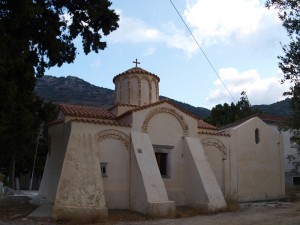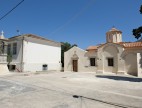All – Holy Virgin Koumbelina at Choumeriako
The church of the All-Holy Virgin the Koumbelina or Koumbelidiki (meaning ‘having a dome’) is built according to the architectural plan of the simple cross-in-square church. A wide barrel-vaulted, transverse narthex was added to the west later. Remains of an arch on the west of the north façade indicate that a barrel-vaulted narthex existed in the same place. The later narthex can be dated to the last two centuries of the Venetian occupation, as can be seen from its construction and the elements of its form, such as the elongated ellipsoid clerestory (skylight) on the upper part of the north façade and the arched opening on the west façade. The interesting doorframe of the entrance on the south façade of the narthex is richly decorated with semi-circular beads, ornamentation on the base of the door frame, a straight door crown and, most distinctively, with an ogee arch on the lintel which ends in a floral ornament while the base ends in volutes. In front of the entrance a simple tomb is built with care. During the 19th century, due to the bad condition of the church, voluminous buttresses were added to the lengthwise sides. The slender dome and the rudimentary cross-groined vaults in the corner bays rest on three piers and one column. Externally the dome is adorned by ten small, clumsily built, arches that rest on limestone small half-columns while its structure mostly resembles the Greek-cross plan. In the north and south façades remains of twin-lobed, arched windows can be discerned. The twin-lobed window on the semi-dome of the apse of the sanctuary was recently restored. The lateral surfaces externally are plastically structured with blind arcades of alternating stone and brick while two blind arcades also survive on the west wall. Three large rectangular windows were built in the lateral sides during the 19th century from local grey limestone. The walls are built with simple masonry, initially covered by off-white plaster with incisions in imitation of opus isodomum. A simple door crown runs around the interior of the church. From the wall painting decoration, only a few remains survive and the Pantocrator in bust on the dome flanked by two medallions with angels, a representation that can be dated to the beginning of the 14th century. Even though the architectural elements of the church connect it to the corresponding middle Byzantine churches of Crete, the excessive simplification of the individual elements, such as the cross-groin vaults, the dome and the arches, lead to a date around the 13th century.




